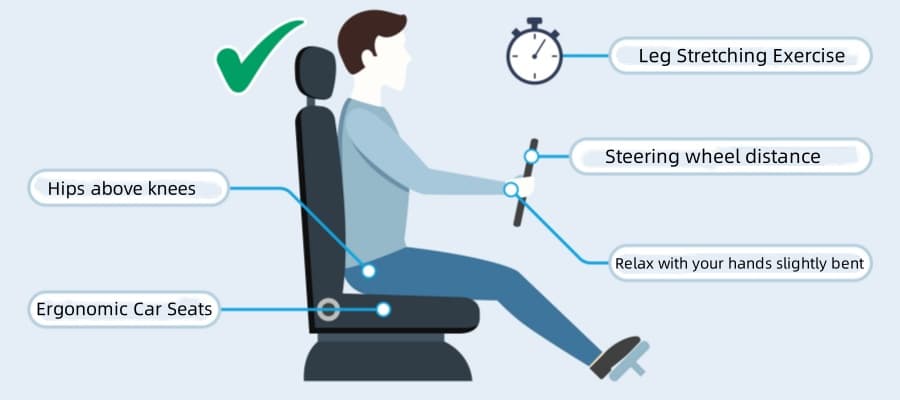Driving for long periods of time or frequently can cause drivers to experience knee pain. Driving with knee pain can affect a driver's safety and comfort, and incorrect driving position can aggravate the discomfort of knee pain and develop into a chronic problem over time. Whether you're a long distance traveler or a driver who specializes in carrying passengers, it's important to understand the importance of proper driving posture and to make adjustments to your driving position to relieve knee pain.

The Importance of Driving Posture for Knee Health
Wrong and improperly adjusted CAR seats can cause the driver's legs to be at an unnatural angle, straining ligaments and muscles. This leads to prolonged pressure on the driver's knee joints, impaired blood flow, and repeated pressure on the pedals, which eventually produces knee pain.
Adjusting the correct sitting position
1, Seat height
When adjusting the seat height, drivers should keep their hips at the same level as their knees, or their hips slightly higher than their knees. Avoid sitting too low or too high, too low will lead to the knees up, too high will lead to the legs hanging, increasing the pressure on the edge of the seat. At the same time the seat height should help the driver to see the road clearly and have no bad effect on the neck and shoulders.
2, Distance from the pedal
In an ideal situation, when the driver fully depresses the pedal (brake or clutch), the knees should be at a comfortable angle, such as slightly curved 20-30 degrees. Ensure that the driver does not need to overextend his legs to comfortably step on the pedal and avoid excessive damage to the knee joint.
3, Seat backrest adjustment
Ergonomic car seats are better able to maintain the natural curvature of the spine, drivers should adjust the angle of the seat back to 100-110 degrees. Prevent the 90-degree upright posture leads to hip flexor tension, pulling the knee or excessive tilt of the seat back makes the driver unable to control the pedals in a normal and stable manner, increasing the pressure on the legs.
4, Steering wheel position
There should be enough space between the steering wheel and the knee, so that the arm is slightly bent and the shoulder is relaxed, to improve the driver's tension seat, reduce the compensatory movement of the legs, and prevent the knee from being pressurized, thus affecting the knee.
5, Choose the right seat
For bumpy and complex road conditions have shock absorption, stability, and buffer van seat can effectively and evenly disperse the weight, reduce the road impact on the knee joints, to avoid the back of the knee blood does not circulate.
Prevention of knee pain
1, every 1-2 hours you can stretch your legs and walk around to prevent stiffness and promote blood flow.
2, Daily simple leg exercises, such as leg stretching or hamstring stretching, to improve muscle flexibility.
3, Use a cushion or rolled up towel behind your knees for extra support.
4, Wear flat-soled, supportive shoes for easy pedal control without straining your ankles or knees.
When doing frequent or long term vehicle driving, we should also choose a high quality, soft, adjustable van seat with shock absorption effect to enjoy ergonomic comfort and protect joints, in addition to by understanding how to correctly adjust the driving seating position. Xiamen Van Seat reminds you to take a moment to adjust the seat when sitting in the car, to be able to feel a better driving experience.
 +86 19906048932
+86 19906048932 sales@luxuryvanseat.com
sales@luxuryvanseat.com | Blog
| Sitemap
| XML
| Privacy Policy
| Blog
| Sitemap
| XML
| Privacy Policy




